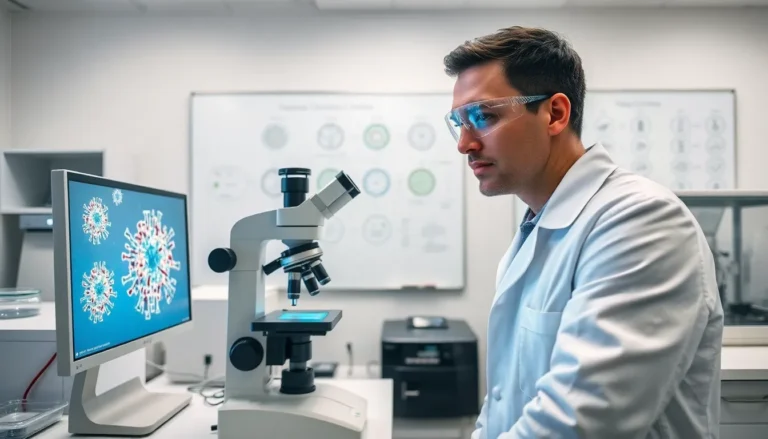Table of Contents
ToggleHave you ever wondered what happens inside a chemical reaction? If you’ve asked yourself how chemists predict what products will emerge from a molecular makeover, you’re not alone. Confidence in predicting products is like being provided with a cheat sheet for that big exam, except it’s science, not calculus. Let’s explore the intriguing realm of chemical reactions and learn how to predict those elusive products, keeping it engaging and a bit humorous along the way.
Understanding Reaction Types

To master the art of predicting products, one must first understand the different types of chemical reactions. There are four main categories: synthesis, decomposition, single replacement, and double replacement. Each has its own unique twist, akin to a plot in a thriller novel.
- Synthesis reactions occur when two or more reactants combine to form a single product. Think of it as forming a new friendship.
- Decomposition reactions do the opposite: a single compound breaks down into two or more products. It’s like that moment when you finally decide to split from your old high school buddy, realizing you’ve both changed.
- Single replacement reactions involve one element replacing another in a compound, reminiscent of changing partners on a dance floor.
- Double replacement reactions are more like a chaotic dance-off, where two compounds exchange partners to create two new compounds.
Understanding these reaction types sets the stage for predicting what products will be formed.
Components of Chemical Reactions
Before predicting products, one should familiarize themselves with the components of chemical reactions. Reactions typically consist of reactants, products, and sometimes catalysts.
- Reactants are the starting materials. They’re the raw ingredients in your chemical kitchen, ready to be whipped into something amazing.
- Products are the end results, the delicious dish served on your chemistry plate.
- Catalysts, while not consumed in the reaction, speed things up, acting like that friend who always nudges everyone to start the party sooner.
By identifying these components, one can make more informed predictions about what products will emerge. Without knowing the ingredients, how can anyone bake a cake?
Common Reaction Mechanisms
Understanding the mechanisms of chemical reactions is vital for accurate product prediction. Few mechanisms occur frequently across various reactions:
- Nucleophilic substitution happens when a nucleophile (an electron-rich species) replaces a leaving group in a compound. Picture a game of musical chairs, where the nucleophile quickly claims the seat when the music stops.
- Elimination reactions occur when elements or groups are removed from a compound, resulting in double bonds or rings. Imagine peeling a banana to get to the good stuff: that’s elimination for you.
- Addition reactions involve the incorporation of atoms into a double or triple bond, effectively intensifying the compound’s complexity. It’s like adding toppings on your pizza: they elevate the experience.
- Redox reactions entail oxidation and reduction occurring simultaneously, often leading to dramatic changes in chemical properties. Think of it as an intense makeover.
Recognizing these mechanisms provides a clearer map for predicting the product of a reaction.
Factors Influencing Product Formation
Several factors can influence product formation in chemical reactions. Understanding these elements enhances predicting abilities:
- Temperature: Higher temperatures typically speed up reactions, sometimes leading to unexpected products. It’s like cooking a steak too quickly and ending up with a well-done disaster.
- Concentration: The concentration of reactants can affect yield. Increased concentration often leads to more product, much like how a packed dance floor creates an electric atmosphere.
- Pressure: Especially relevant in gaseous reactions, manipulating pressure can shift equilibria, influencing product outcomes. Imagine trying to pop a balloon: the more pressure you apply, the faster it bursts (if you’re not careful.).
- Catalysts: As mentioned before, these unsung heroes certainly speed up reactions and can sometimes direct the product towards a more favorable outcome.
Example Reactions and Predictions
Let’s put theory into practice with some example reactions:
- Synthesis reaction: If hydrogen gas (2H2) reacts with oxygen gas (2O2), the product is water (2H2O). This straightforward reaction showcases how two simple gases combine to form a compound essential for life.
- Decomposition reaction: In the decomposition of calcium carbonate (2CaCO3), heat causes it to break into calcium oxide (2CaO) and carbon dioxide (2CO2). Here, heat acts as a catalyst for transformation.
- Single replacement reaction: When zinc (2Zn) displaces copper (2Cu) in copper(II) sulfate (2CuSO4), the result is zinc sulfate (2ZnSO4) and copper metal (2Cu). It’s as if zinc swoops in, taking copper’s place in the spotlight.
- Double replacement reaction: When barium chloride (2BaCl2) reacts with sodium sulfate (2Na2SO4), they exchange components to form barium sulfate (2BaSO4) and sodium chloride (2NaCl). A classic case of partners switching without any hard feelings.
These examples illuminate how knowing the types of reactions and their components allows for accurate predictions.
Applications of Predictive Reaction Modeling
Predictive reaction modeling holds immense significance in various fields:
- Pharmaceutical development: Organizations use predictive models to forecast reaction outcomes, leading to the design of new drugs with minimal trial and error.
- Environmental chemistry: Understanding chemical reactions can help predict pollutant behaviors and how to tackle environmental issues effectively. It’s like learning where to place the sandbags during a flood.
- Material science: Architects of materials employ reaction predictions to create new compounds with desired properties, paving the way for innovative technologies.
The implications of predictive modeling stretch far and wide, showcasing the power of chemistry in addressing real-world problems.







